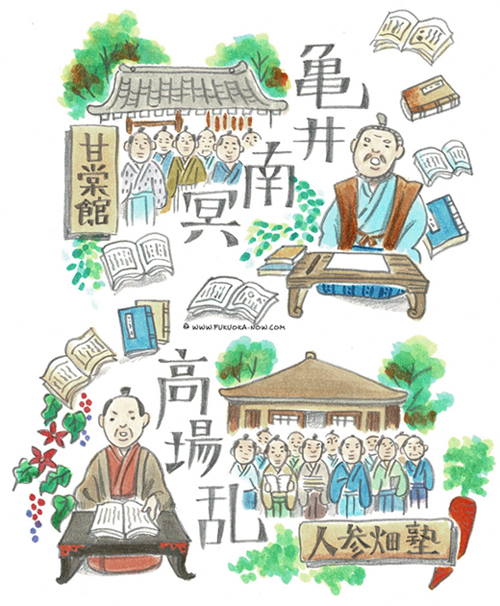Hakata Culture vol.164
A Tale of Two Local Doctors and Educators: Nanmei Kamei and Osamu Takaba

This month’s article focuses on two doctors and educators from Fukuoka who were active in the Edo and Meiji eras. The first, Nanmei Kamei (1743 - 1814), was born in Meinohama (now part of Nishi Ward) as the son of the village doctor. He was studious from a young age, and he went to Edo at the age of 19 to study medicine and Confucianism. He returned to Fukuoka to work as a doctor in what is now Tojinmachi, and many pupils studied under him at his Kamei Juku school.
His work would later earn praise, and he was chosen to serve as the jui (Confucian scholar and doctor) of the Fukuoka Domain. He also served as the first president of the domain’s Kantokan academy. He was the first scholar to present an academic theory on the Gold Seal that was unearthed in Shikanoshima, but this was later discredited. The Kantokan was shut down after it was destroyed by fire, but Nanmei, along with his son Shoyo, reopened the Kamei Juku, which is said to have attracted pupils from all over Japan.
One of the school’s pupils was Osamu Takaba (1831 - 1891). Born as the daughter of an eye doctor for the Fukuoka Domain, Osamu was raised as a boy because the family had no sons. Osamu dressed like a man and was permitted to carry swords like a man. After undergoing schooling at the Kamei Juku, Osamu opened a private academy commonly referred to as the Ninjin-batake Juku (lit., “Carrot Field Academy”) because it was located on the former site of the Fukuoka Domain’s medicinal carrot field near present-day Hakata Station. Like Nanmei, Osamu was both a doctor and an educator.
The graves of Nanmei and Shoyo Kamei are located inside Jomanji Temple in Jigyo. The impressive Sanmon Gate of this temple is said to have been built in the Edo era when the Kameis were still practicing their profession. There is also a stone monument in Tojinmachi marking the site where the Kantokan once stood. Osamu Takaba’s grave lies within the premises of Sofukuji Temple in Chiyo, Hakata Ward, and the inscription on the tombstone was written by Katsu Kaishu, a famous statesman of the late Edo and early Meiji eras. There is also a stone monument near Hakata Station marking the former site of the Ninjin-batake Juku.
医者であり教育者:亀井南冥(かめい なんめい)と高場乱(たかばおさむ)
今回は江戸時代から明治時代にかけての医者であり教育者であった2人の人物を紹介します。1人目は亀井南冥(1743~1814年)です。南冥は早良郡姪浜村(現在の西区姪浜)の町医者の息子として生まれ、幼い頃から勉学に励み、19歳のときに京へ上って医学と儒学を学びます。福岡に戻ると現在の唐人町で医者として開業するかたわら、私塾「亀井塾」を開いて多くの門人を育てました。
やがてその活動が評判を呼び、福岡藩の儒医(儒者兼医師)に抜擢されます。さらに新設された西学問所「甘棠館(かんとうかん)」の初代学長になりました。志賀島で発見された金印についての学説をいち早く発表するなど活躍しますが、後に失脚。さらに甘棠館は焼失して廃止になります。けれども息子の昭陽(しょうよう)とともに亀井塾を再開し、日本全国から門弟が集まったとされます。
この亀井塾から育ったのが高場乱(1831~1891年)です。福岡藩医の眼科医の家に生まれた女性ですが、跡取りの男児がいなかったことから、幼い頃から男として育てられた男装帯刀の女性儒学者でした。亀井塾で学んだ後に、現在の博多駅近くにあった福岡藩の薬用人参畑跡に自身の私塾、通称「人参畑塾」を開設します。亀井南冥と同じく、医師のかたわら教育に携わる道を選びました。
亀井南冥、昭陽の墓は、中央区地行の浄満寺(じょうまんじ)の境内にあります。この寺に残る立派な山門は、亀井親子が活躍した江戸時代に造られたものと伝わっています。また、唐人町にあった西学問所「甘棠館」の跡地には石碑が建っています。高場乱の墓は博多区千代の崇福寺にあり、墓碑銘は勝海舟が書いたものです。また、博多駅近くの人参畑塾跡にも石碑が建っています。

